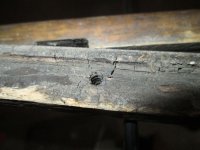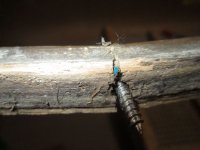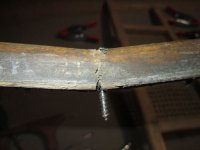Recently there has been some discussion on how to attach gunnels to a canoe. Screws ? or Glue !
Gluing provides Strength the Full length of the gunnel. Screws hold the gunnels on the hull, at the expense of weakening the gunnel by drilling a hole for a screw screw.
Up until now, virtually every set of wooden gunnels, put on a canoe, by the Manufacturers, were held in place by screws.
Why not ? They could be installed in short order, and the screws, gave them that Old Time look ! Just like Old Town did, on their Wood Canvas canoes !
In my shop right now, is a Mad River Kevlar Explorer. It's a typical "Factory" canoe.
The gunnels from a distance didn't look to bad, until I started pulling screws.
I took some pics and thought I'd show the flaws I see in using screws, as opposed to gluing ( Epoxy+fillers).
My guess is if these gunnels were Glued ? They would still be in usable condition, after having been put through the same conditions.
Almost every screw in the Outwhale, (and the screw holes were drilled from the inside out), split the Outwhale. Allowing another point of entrance for moisture. The screws hold the gunnels tight at the screw, but between the screws ? Not so much. Mad River machines a Lip in the Outwhale to cover the hull.


The Inwhale broke at a screw hole. Had it been glued ? Hard to to tell if the Inwhale would have failed. One thing for sure is water found it's way into the wood, and did it's thing.


Gluing provides Strength the Full length of the gunnel. Screws hold the gunnels on the hull, at the expense of weakening the gunnel by drilling a hole for a screw screw.
Up until now, virtually every set of wooden gunnels, put on a canoe, by the Manufacturers, were held in place by screws.
Why not ? They could be installed in short order, and the screws, gave them that Old Time look ! Just like Old Town did, on their Wood Canvas canoes !
In my shop right now, is a Mad River Kevlar Explorer. It's a typical "Factory" canoe.
The gunnels from a distance didn't look to bad, until I started pulling screws.
I took some pics and thought I'd show the flaws I see in using screws, as opposed to gluing ( Epoxy+fillers).
My guess is if these gunnels were Glued ? They would still be in usable condition, after having been put through the same conditions.
Almost every screw in the Outwhale, (and the screw holes were drilled from the inside out), split the Outwhale. Allowing another point of entrance for moisture. The screws hold the gunnels tight at the screw, but between the screws ? Not so much. Mad River machines a Lip in the Outwhale to cover the hull.


The Inwhale broke at a screw hole. Had it been glued ? Hard to to tell if the Inwhale would have failed. One thing for sure is water found it's way into the wood, and did it's thing.


